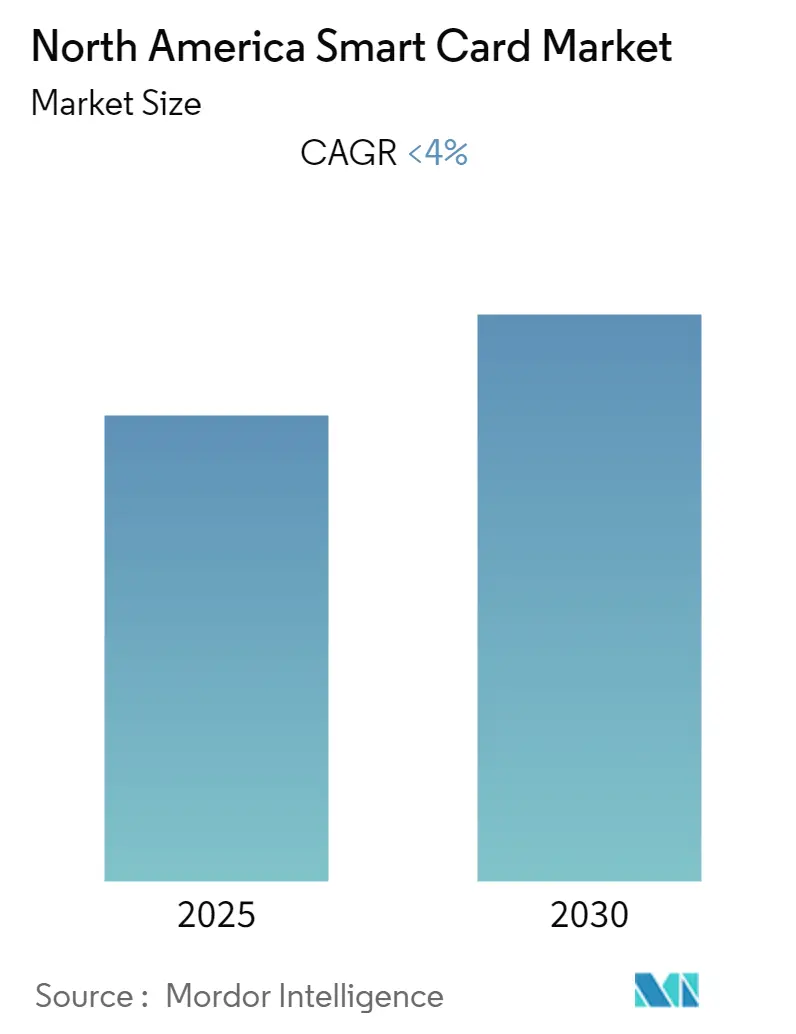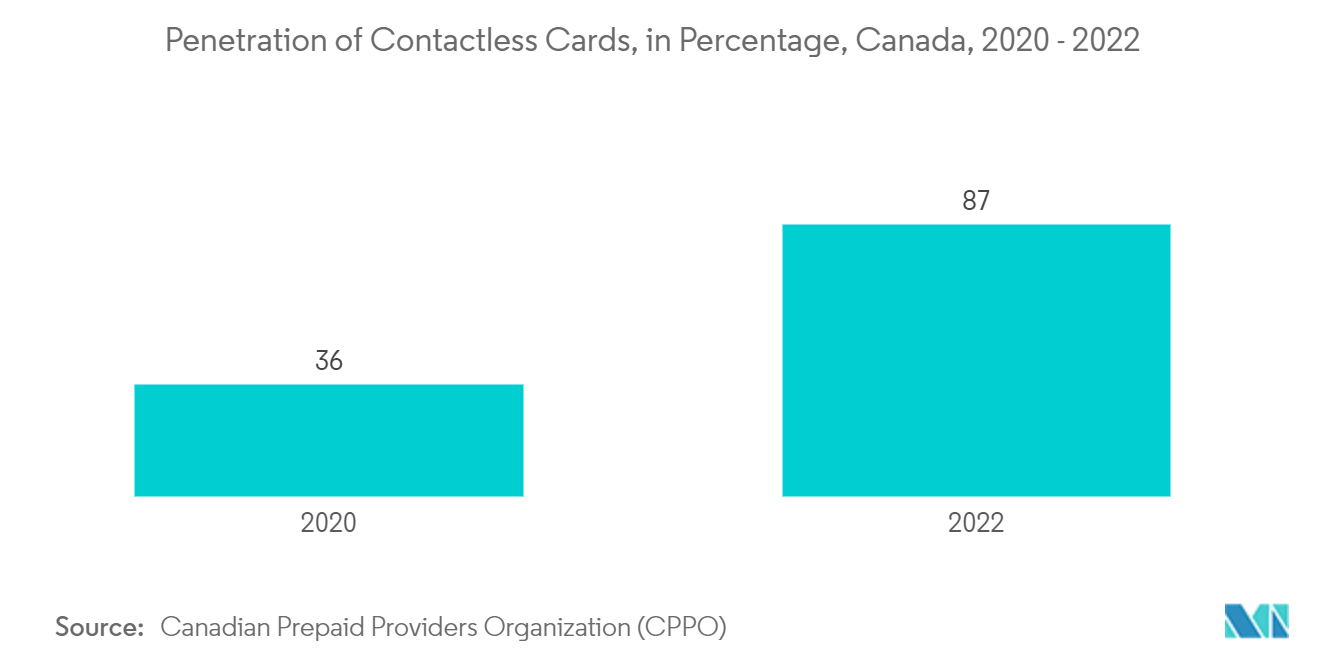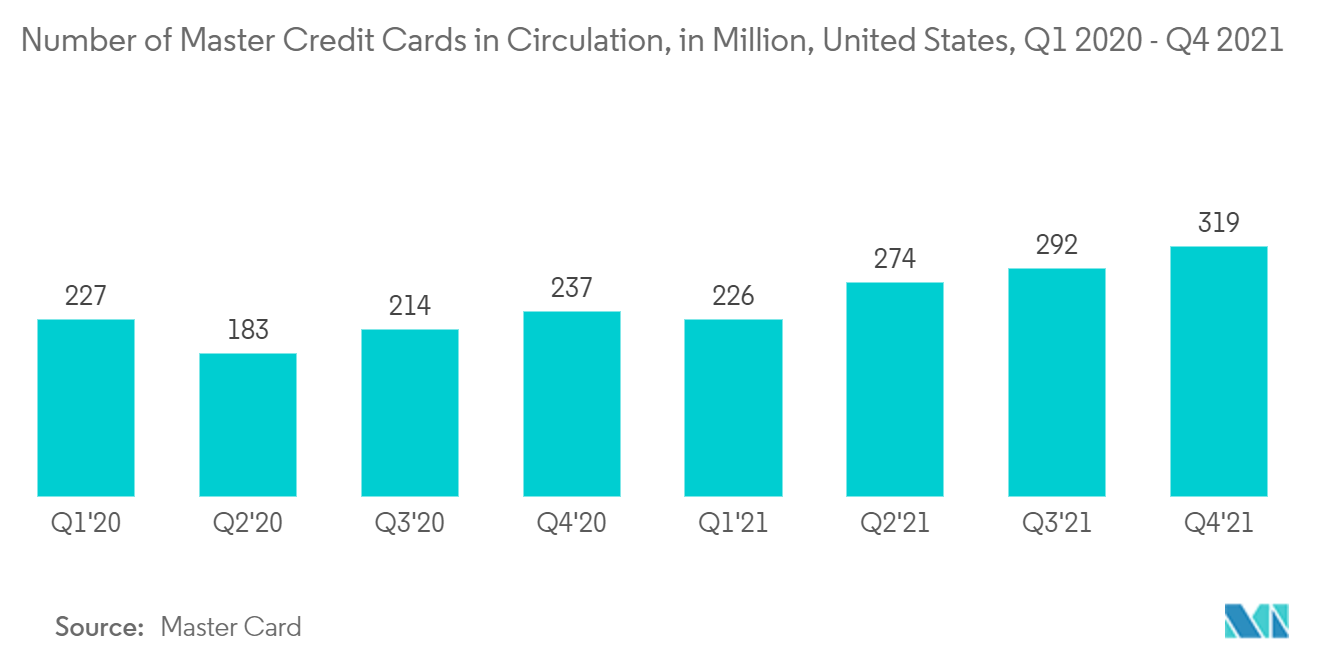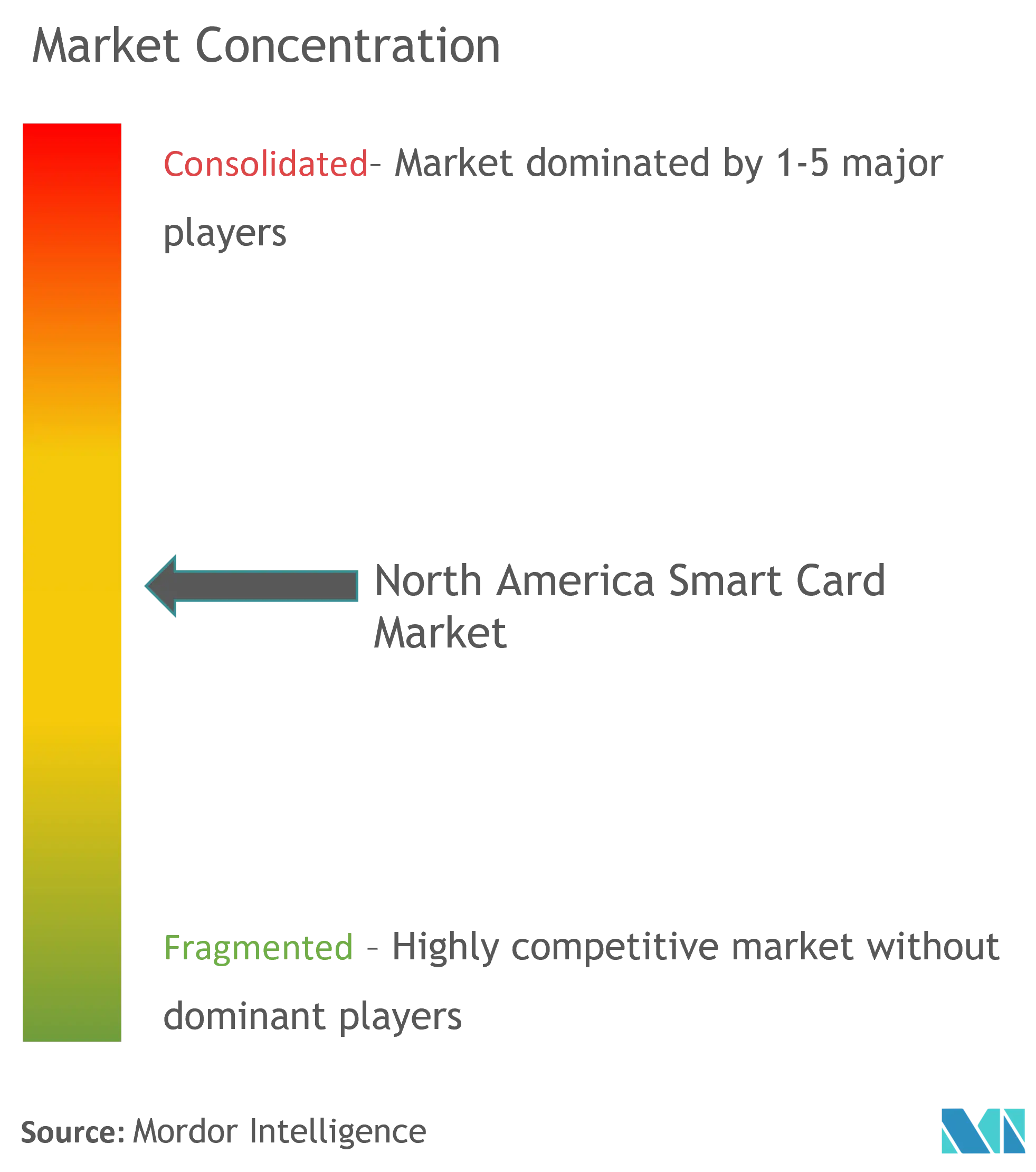
North America Smart Card Market Analysis by Mordor Intelligence
The North America Smart Card Market is expected to register a CAGR of less than 4% during the forecast period.
- In North America, Government policymakers are looking carefully at the best ways to improve the efficiency of information systems in the healthcare industry vertical. Much emphasis has been placed on the need for electronic health records for every American and on ways to exchange those records at all levels, and smart card technology has emerged to be among the key technology enabler for those organizations.
- Considering the benefits of smart cards, several states, including California, New York, and Louisiana, in the United States of America have already started providing Smart Health Card. Technology from the Boston Children's Hospital was used to create these cards.
- The advent of smart cards has made payment methods faster and safer. The market is also expected to witness considerable growth because of the increase and advancement in the financial and banking sector. Contactless smart cards have become the leading choice for financial services and governments. According to data provided by Visa, in April 2021, over 300 million Visa cards will be contactless-enabled, a significant portion of active credit and debit cards in the United States.
- With the emergence of technologies like blockchain, IoT, and biometrics, there has been a growth in the smart card market. Healthcare, smart city, consumer electronics, industrial, payments, and numerous other verticals are developing services that rely on an IoT (Internet of Things) infrastructure.
- However, security has been among the major factor challenging the growth of the studied market, as a significant number of cases has been reported in the North American region that involved cards.
- The outbreak of Covid-19 significantly impacted the North American region. Although a majority of the industrial and commercial sectors were affected by the pandemic, the use of smart cards for contactless payment and information sharing has witnessed an upward trend expected to sustain and positively impact the studied market growth during the forecast period.
North America Smart Card Market Trends and Insights
Contactless Cards are Expected to Drive the Market Growth
- Although contactless payment was also gaining popularity in the North American region before the COVID-19 outbreak, the pandemic has significantly accelerated the adoption rate of contactless cards. Fast forward to 2022, this form of payment has become the new norm as businesses and consumers look toward safer, quicker ways to pay, largely due to COVID-instigated habitual change and evolving payment habits.
- The growing adoption of cashless or digital payments positively influences smart cards in everyday use, such as paying utility bills and prepaid mobile recharge. Several government agencies in the North American region are also promoting smart cards. For instance, the U.S. Federal government has standardized smart cards for employee and contractor identification cards. New identity programs also specify smart cards for citizens, transportation workers, and first responders.
- In Canada, the need for the security of applications that employ critical information, credentials, and documents has also increased the demand for smart cards, which enhance security through encryption. For instance, according to Payments Canada's 2021 report, about 62% of Canadians reported using cash-less rather than pre-pandemic, and 42% now avoid shopping at places wherein contactless payments are not accepted.
- In the United States, by issuing secure contactless smart cards, financial service providers are not only supplying consumers with a more convenient payment mechanism, but they are also increasing transaction volumes by replacing cash, thereby resulting in the significant growth of the contactless smart cards market.

United States to Hold Significant Market Share
- The United States uses many emerging technologies, and the country is making many advancements in smart card technology. One of the most important factors propelling the demand for smart cards in the country is that smart-card-based physical access control systems are powerful and efficient security tools for protecting enterprise assets.
- The private enterprises and government agencies of the United States are increasingly implementing smart card-based access control systems. For instance, the United States Department of Defense (DoD) Common Access Card (CAC) is one of the country's most advanced smart ID card programs. These smart cards serve as the DoD standard identification for active duty military personnel, civilian employees, selected reserve personnel, and eligible contractor personnel.
- Several government agencies in the United States are also leveraging issued CAC and PIV smart cards to e-sign documents for many use cases such as e-contracting, Finance, procurement, and HR, among others. For instance, by inserting their LincPass smartcard into a slot on their keyboard or laptop, USDA employees with smart cards can e-sign documents. Successful authentication by smart card enables them to apply their e-signature to documents for full non-repudiation.
- Across the financial sector of the country as well, the demand for smart cards has been increasing as consumers are increasingly opting for cards that can provide enhanced security as well as new features. The card providers are also actively responding to such trends. For instance, in 2021, Mastercard announced that banks in the United States will no longer be required to issue chip cards with a magnetic stripe starting in 2027.
- As the number of payment cards issued by the banking and financial institutions in the country is increasing, the studied market is expected to be impacted positively during the forecast period. For instance, in Q2 2021, there were about 742 million Visa cards in circulation in the United States (Source: Visa Inc.)
- Furthermore, the Healthcare sector in the United States is at a pivotal point in its development and is propelling the need for smart cards. Smart health cards improve patient information privacy, provide security and a secure carrier for portable medical records, and reduce healthcare fraud. Considering the benefit these card offers, several states have already started adopting smart health cards, the uses of which are expected to grow further in the next few years.

Competitive Landscape
The North America Smart Card Market Market is competitive and consists of several partakers like CardLogix Corporation, Secura Key, IDEMIA, HID Global Corporation, Fingerprint Cards AB, and many more. The companies are focusing on increasing their market presence by developing innovative technologies, forming multiple partnerships, investing in projects, and launching new products in the market.
- June 2022 - The Alpharetta Department of Public Safety announced that the agency has partnered with Montana-based Police Smart Card on a pilot program to replace police officers' business cards with fully featured smart cards. According to the agency, the cards enable a citizen to scan a QR code on the card to access a police officer's badge information and download a vCard with the case number and the officer's contact information.
- April 2022 - FinTech startup Savvii Group Inc. had secured USD 10 million in seed funding that closed at the end of the last quarter. The company is planning to enter the Canadian consumer card market, and the funding will allow Savvii to accelerate the development of its tech infrastructure and build out its partner network.
North America Smart Card Industry Leaders
-
CardLogix Corporation
-
Secura Key
-
HID Global Corporation
-
IDEMIA France SAS
-
Fingerprint Cards AB
- *Disclaimer: Major Players sorted in no particular order

Recent Industry Developments
- April 2022 - Thales Trusted Cyber Technologies (TCT), a U.S.-based cyber security firm, announced that its Smart Card 650 v4.2 token (SC650) had received approval from the National Security Agency (NSA) for use in defense networks. The SC650 is a high assurance identification and authentication smart card that brings two-factor authentication to networks and applications where security is critical.
- September 2021 - Fingerprint Cards AB announced a collaboration with Infineon technologies. As per the agreement, Fingerprint Cards AB enabled biometric authentication is to be executed within Infineon Technologies Secure Element, making it easier for card manufacturers to develop and roll out biometric payment cards at scale. This technological leap has been achieved while maintaining biometric performance and increasing security.
- August 2021 - RBC Ventures launched Mydoh, an innovative money management app and Smart Card in Canada. The company has designed the app and smart card to help kids make their own earning and spending decisions. Upon signing in to the app, the customers get access to a digital visa card immediately, and then they receive a physical Visa Prepaid card.
- July 2021 - Giesecke+Devrient (G+D) acquired Pod, a provider of IoT sim cards. With billions of IoT devices generating data, data authenticity, privacy, and security are fundamental to making IoT successful and beneficial for its users. Pod and the company's products complement the G+D eSIM card portfolio and provide the ability to connect, manage, bill, and secure devices via a seamless and cost-effective approach.
North America Smart Card Market Report Scope
A smart card is a device similar to a credit/debit card that uses a small microchip to store and process data. As these cards can handle more information and provide more functionality, they are increasingly being used across various industries.
The study tracks the trends and historical data related to smart card usage across various end-user verticals of the North American region, such as BFSI, IT and Telecommunication, etc. It also includes the impact assessment of COVID-19 on the studied market.
| Contact-based |
| Contact-less |
| BFSI |
| IT and Telecommunication |
| Government |
| Transportation |
| Other End-user Industries (Education, Healthcare, Entertainment, etc.) |
| United States |
| Canada |
| By Type | Contact-based |
| Contact-less | |
| By End-User Vertical | BFSI |
| IT and Telecommunication | |
| Government | |
| Transportation | |
| Other End-user Industries (Education, Healthcare, Entertainment, etc.) | |
| By Country | United States |
| Canada |
Key Questions Answered in the Report
What is the current North America Smart Card Market size?
The North America Smart Card Market is projected to register a CAGR of less than 4% during the forecast period (2025-2030)
Who are the key players in North America Smart Card Market?
CardLogix Corporation, Secura Key, HID Global Corporation, IDEMIA France SAS and Fingerprint Cards AB are the major companies operating in the North America Smart Card Market.
What years does this North America Smart Card Market cover?
The report covers the North America Smart Card Market historical market size for years: 2019, 2020, 2021, 2022, 2023 and 2024. The report also forecasts the North America Smart Card Market size for years: 2025, 2026, 2027, 2028, 2029 and 2030.
Page last updated on:
North America Smart Card Market Report
Statistics for the 2025 North America Smart Card market share, size and revenue growth rate, created by Mordor Intelligence™ Industry Reports. North America Smart Card analysis includes a market forecast outlook for 2025 to 2030 and historical overview. Get a sample of this industry analysis as a free report PDF download.
.webp)


